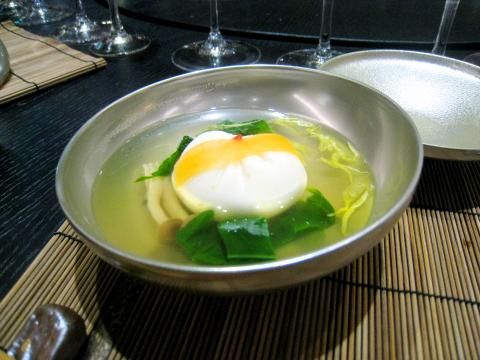The understated facade of Toutouan (燈燈庵), a new kaiseki (懷石料理) restaurant that opened off Taipei’s swank Anhe Road last week, conceals some very considerable ambitions.
This is the first venture of the Tokyo restaurant of the same name outside of Japan, and is the result of a collaboration between Toutouan and the Hong Kong-based Inno Hospitality Company (香港宜諾管理顧問公司).
With its unique mixture of contemporary design, ritual and fine cuisine, Taipei’s Toutouan has aspirations in food and service that exceed five-star standards.

Photo: Ian Bartholomew, Taipei Times
Kaiseki usually refers to a multi-course Japanese meal, one that seeks to present exceptionally fine ingredients in dishes that thoughtfully combine flavors and exquisite visual appeal, with a formal style of service.
Despite its location and unexciting minimalist design, Toutouan generally achieves its ambitions. There is no a la carte menu, only a selection of four set menus for lunch (from NT$800 to NT$1,800 per person) and four for dinner (from NT$1,800 to NT$3,000). Currently the restaurant is also offering a number of wine pairing menus starting at NT$550.
The concept behind Toutouan is to provide a total dining experience designed by experts to maximize diners’ enjoyment.

Photo: Ian Bartholomew, Taipei Times
According to Jennifer Wang (王玨驎), a wine consultant at Inno, great effort was made to find wines that are not normally found in Taipei.
Toutouan places heavy emphasis on using local ingredients, though the owners of the parent restaurant decided not to compromise with fundamentals such as soy sauce, miso seasoning, vinegar and salt, which are all imported.
As some of the food is extraordinarily simple, the quality of these ingredients is critical.
A dish such as the crab meat bun (蟹肉饅頭) is a case in point: it is actually a light crab meat dumpling (shaped like a steamed bun) in a light stock. The soup, light and clear, is so refined and fresh that it shocks the palette into self-awareness — a Zen-like experience. The crab dumpling looks like a heavy white lump, but bite into it and you discover an airy mousse-like consistency. The whole dish is an astonishing balancing act. This is just one of many dishes that manage to express a deeply felt conceptual element that is integral to many of the creations at Toutouan.
The food at Toutouan is inspired by the formality of the Japanese tea ceremony. A dish such as smoked duck breast with figs poached in red wine is served at the table, the ingredients being presented to the guest before the chef plates the food. The meat is carved in front of the diner, and then the chef creates a small, transient work of art.
The antipasti dish is a masterwork, using simple, even rustic, ingredients, but presenting them in such a ceremonious fashion that you cannot help but take notice.
Simplicity at Toutouan is the result of great attention to detail, and a similar attention to detail is required by the diner to get the most out of the experience.

That US assistance was a model for Taiwan’s spectacular development success was early recognized by policymakers and analysts. In a report to the US Congress for the fiscal year 1962, former President John F. Kennedy noted Taiwan’s “rapid economic growth,” was “producing a substantial net gain in living.” Kennedy had a stake in Taiwan’s achievements and the US’ official development assistance (ODA) in general: In September 1961, his entreaty to make the 1960s a “decade of development,” and an accompanying proposal for dedicated legislation to this end, had been formalized by congressional passage of the Foreign Assistance Act. Two

Despite the intense sunshine, we were hardly breaking a sweat as we cruised along the flat, dedicated bike lane, well protected from the heat by a canopy of trees. The electric assist on the bikes likely made a difference, too. Far removed from the bustle and noise of the Taichung traffic, we admired the serene rural scenery, making our way over rivers, alongside rice paddies and through pear orchards. Our route for the day covered two bike paths that connect in Fengyuan District (豐原) and are best done together. The Hou-Feng Bike Path (后豐鐵馬道) runs southward from Houli District (后里) while the

March 31 to April 6 On May 13, 1950, National Taiwan University Hospital otolaryngologist Su You-peng (蘇友鵬) was summoned to the director’s office. He thought someone had complained about him practicing the violin at night, but when he entered the room, he knew something was terribly wrong. He saw several burly men who appeared to be government secret agents, and three other resident doctors: internist Hsu Chiang (許強), dermatologist Hu Pao-chen (胡寶珍) and ophthalmologist Hu Hsin-lin (胡鑫麟). They were handcuffed, herded onto two jeeps and taken to the Secrecy Bureau (保密局) for questioning. Su was still in his doctor’s robes at

Mirror mirror on the wall, what’s the fairest Disney live-action remake of them all? Wait, mirror. Hold on a second. Maybe choosing from the likes of Alice in Wonderland (2010), Mulan (2020) and The Lion King (2019) isn’t such a good idea. Mirror, on second thought, what’s on Netflix? Even the most devoted fans would have to acknowledge that these have not been the most illustrious illustrations of Disney magic. At their best (Pete’s Dragon? Cinderella?) they breathe life into old classics that could use a little updating. At their worst, well, blue Will Smith. Given the rapacious rate of remakes in modern